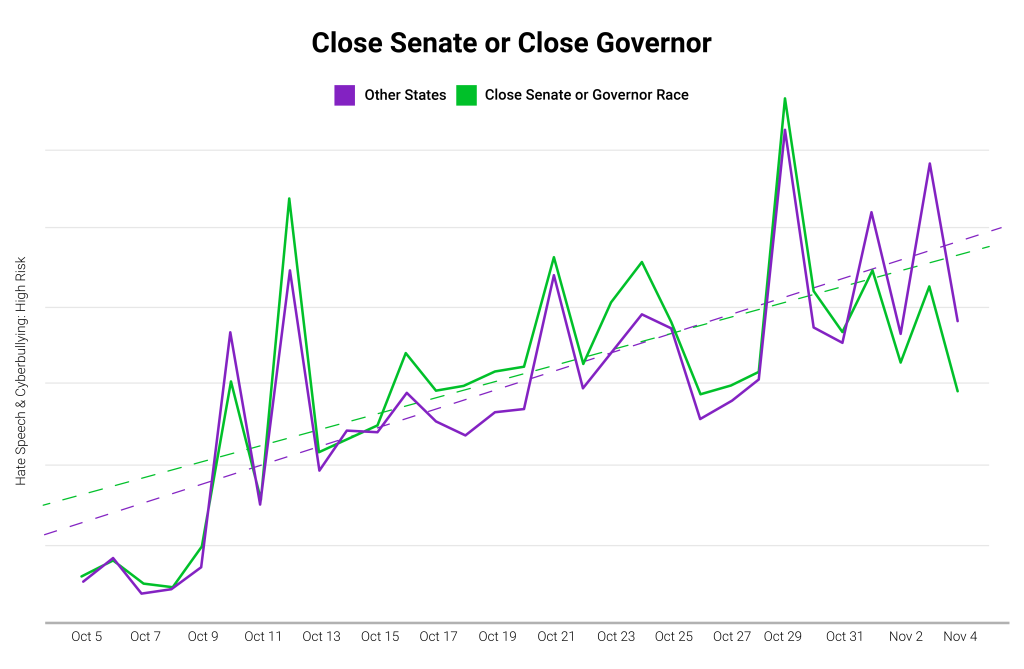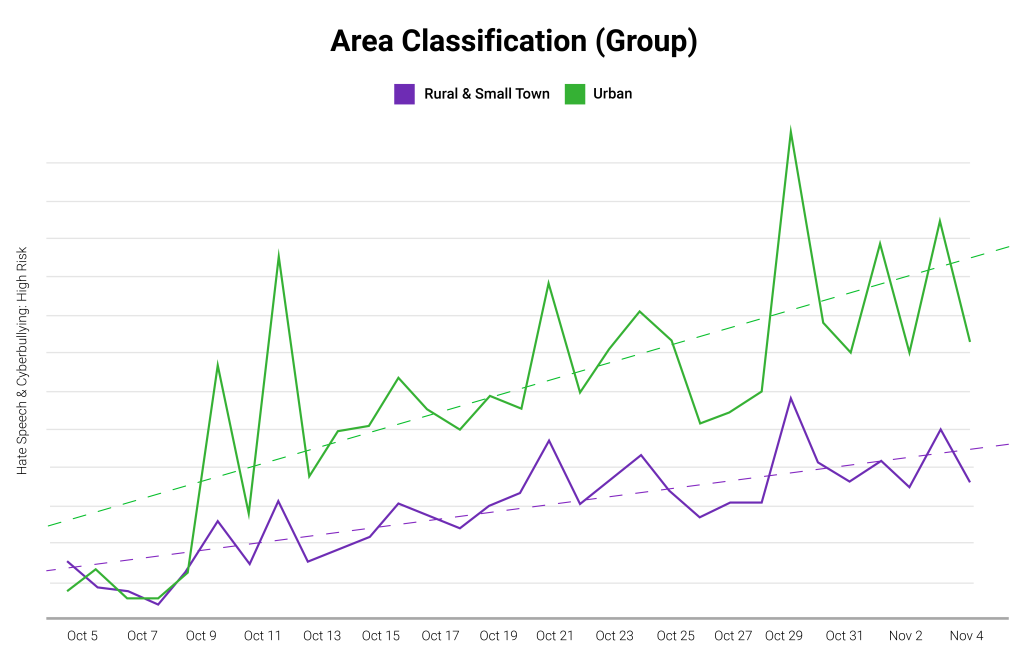To help understand traffic patterns around volatile news cycles, the DoubleVerify (DV) Election Task Force began tracking content related to the U.S. midterm elections. Specifically, DV’s team of ontologists and analysts followed High-Risk Hate Speech, content surrounding the top 10 midterm voting issues (per Pew Research) and Inflammatory Politics and News content pertaining to these top 10 issues. As October and November progressed, three distinct trends have emerged.
Three Content Trends Persist Across the Fall
- High-Risk Hate Speech has steadily climbed week-over-week relative to the baseline rates of the later summer and early fall (August 22 – October 4).
- High-Risk Hate Speech has proliferated at a greater rate across urban areas than across rural areas.
- Abortion has consistently been the most prevalent topic across DV-tracked midterm election content. But abortion discussion seemingly generates less disinformation and misinformation; when it has come to DV-tracked Inflammatory Politics and News content, however, abortion continues to rank fourth in prevalence.
Read on for a detailed analysis of these three trends and a look ahead at what to expect in the weeks leading up to the Georgia run-off election.
High-Risk Hate Speech Snapshot
Across all states, High-Risk Hate Speech rates rose 34% week-over-week. This follows the drastic increases seen during our previous analyses (+95% from October 5 – October 21 and +45% from October 22 – October 28).
High-Risk Hate Speech Rates (States with Close Statewide Elections vs. All Other States)

Three distinct spikes appeared over October 29 – November 4 that seemingly coincide with:
- The attack on Nancy Pelosi’s spouse, Paul Pelosi (initially reported on October 28)
- The ABC interview with the second woman to accuse Herschel Walker of pressuring her into an abortion (November 1)
- News related to Trump’s ongoing legal troubles in New York State and his filing of a lawsuit against NYS AG Leticia James (November 3)
Unlike the previous week, however, where DV observed no difference in relative rate of increase for High-Risk Hate Speech between states with close Senate or Governor races versus all other states, a distinct difference in High-Risk Hate speech rates emerged during the week of October 29 – November 4. The average rate of High-Risk Hate Speech in states with close races rose by just 19% over the week of October 29 – November 4 when compared with the week prior. But in states without close elections, High-Risk Hate Speech rates rose by 44% during the same period.
Key Takeaways
The rate of High-Risk Hate Speech continues to differ between urban and rural subgroups (as classified by the USDA). During the week of October 29 – November 4, however, High-Risk Hate Speech increased by 34% across urban areas and 16% across rural areas. The rate of High-Risk Hate Speech is now 112% higher in urban areas than in rural ones.
High-Risk Hate Speech Rates (Urban Areas vs. Rural Areas)

Topics Surrounding the Midterm Elections – and Those Prevalent Across Inflammatory Politics and News
Although abortion content within DV-tracked midterm election subsided by 42% week-over-week (from 51% of DV-tracked midterm election content from October 22 – October 28 to 30% from October 29 – November 4), it still remains the most prevalent subject of the top voting issues (per Pew Research) that DV is tracking.
In the week leading up to the election, content discussing violent crime remained steady, at 29%. And content discussing the economy dropped by 37% (from 32% of DV-tracked midterm election content to 20%).

Among the pages DV sampled that were categorized as Inflammatory Politics and News, violent crime again became the most prevalent topic, with energy policy and the economy following, respectively. Abortion remained the fourth most prevalent topic across Inflammatory Politics and News pages.

Top 5 States for High-Risk Hate Speech and Inflammatory Politics and News
The latest geographic ranking of High-Risk Hate Speech and Inflammatory Politics and News by rate during the week of October 29 – November 4 shows New York and Ohio with the most in each category respectively, which is a notable difference. Previously, Mississippi and Wyoming ranked the highest for High-Risk Hate Speech and Inflammatory Politics and News, respectively, from October 5 – October 28.
- Top 5 High-Risk Hate Speech States:
- New York
- Mississippi
- Georgia
- Louisiana
- Illinois
- Top 5 Inflammatory Politics and News (IPN) States:
- Ohio
- West Virginia
- Texas
- Arizona
- Oklahoma
What to Know Following the Midterms and As the Georgia Run-Off Approaches
The consistent rise of High-Risk Hate Speech rates reflect a volatile news cycle – one that may persist as the Georgia run-off approaches. The DV Election Task Force will continue monitoring the situation in real time. And, beyond the Georgia run-off, the Task Force’s work will continue in preparation for the upcoming primaries and general elections in 2024 and monitoring Inflammatory Politics and News and High-Risk Hate Speech rates.
If you have questions about brand safety and suitability as it pertains to the election news cycle, please reach out to Sales@DoubleVerify.com.
Appendix
DV analyzes billions of impressions a day spanning websites, mobile apps, message boards and blogs to help keep brands safe from appearing alongside content they deem unsafe or unsuitable. Publishers promoting specious or racially biased/motivated claims are classified into DV’s Inflammatory Politics and News and Hate Speech categories.
DV’s ongoing analysis of category traffic rates associated with High-Risk Hate Speech began on August 1 and compares states with close Senate and Gubernatorial races to those without any close races. Between August 1 and August 22, the average rate of High-Risk Hate Speech was the same for both subsets of states. As the midterm election cycle went into full swing, we observed that the average rate of High-Risk Hate Speech increased markedly.
How DV Defines Close Races, Rural and Urban Areas and Top Voting Issues
Close Races: DV’s list of close races is composed of “battleground” races identified by the nonprofit and nonpartisan online political encyclopedia Ballotpedia.
Rural and Urban Areas: The subgroups we designated as “urban” and “rural & small town” were derived using the rural-urban commuting area code (RUCA) classifications from the US census, listed as: metropolitan, micropolitan, small town and rural. Any areas designated metropolitan and micropolitan were grouped as “urban” in our analysis, while the remaining areas were grouped as “rural & small town.”
Tracking Topics Among Election-Related and Inflammatory Politics and News Web Pages
The DV ontology team uses machine learning to analyze web page content and identify topics being discussed. This capability allowed DV’s task force to track the frequency and prevalence of specific topics being mentioned over time.
Beginning in mid-September, the ontology team identified pages where midterm elections were mentioned and tracked the percentage of pages where the top 10 midterm voting issues appeared (i.e. % of total sample). The top 10 voting issues we tracked (per Pew Research) are listed here alphabetically:
- Abortion
- Economy
- Education
- Energy Policy
- Gun Policy
- Health Care
- Immigration
- Supreme Court Appointments
- Violent Crime
- Voting Policy
Beginning the week of September 24 – September 30, DV began analyzing the percentage of pages that mentioned these topics and were also categorized as Inflammatory Politics and News.
Glossary of Terms
Category Traffic Rates: Category traffic rates are defined as the percentage of all DV monitored ad calls that were adjacent to content classified within a specific category. This serves as a proxy for overall traffic trends.
Hate Speech/Hate Speech & Cyberbullying (overall category definition): These terms may be used interchangeably and refer to content that is related to biased, derogatory, or offensive actions towards any individuals or groups. Content that may incite violence against individuals or groups within a protected class is also within the category.
- Please note, the overall category is not limited to instances of harmful language or behavior; it also includes content about such language or behavior, such as news coverage about a hate crime or cyberbullying, as well as content about groups that are associated with such activities.
High-Risk Hate Speech/Hate Speech & Cyberbullying (High Risk): These terms may be used interchangeably and refer to content that includes hate speech or derogatory terms in a demeaning, harmful manner; discussion of hate crimes, hate groups, hate speech, and cyberbullying in user-generated and/or unmoderated content; content that promotes or glorifies hate groups; content that provides information on how to commit cyberbullying or hate crimes; content that is related to biased, derogatory or offensive actions towards any individuals or groups; content that may incite violence against individuals or groups within a protected class is also within the category.
Inflammatory Politics and News: News or political content associated with or exhibiting inflammatory points of view; potentially fake, unreliable or unsubstantiated information; significant political intolerance, hateful or threatening rhetoric; or other significantly controversial elements.
Previous Election Coverage

